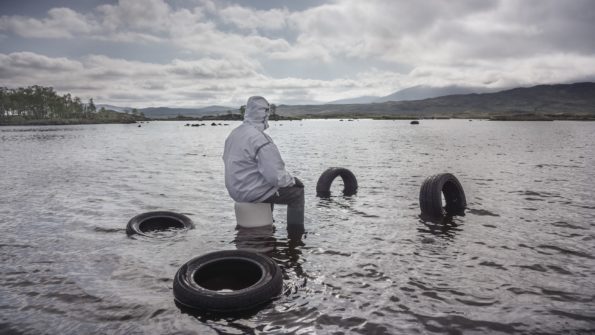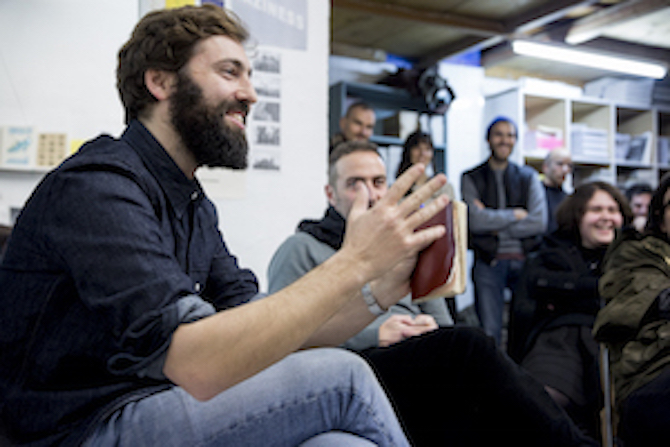Search
To search for an exact match, type the word or phrase you want in quotation marks.
A*DESK has been offering since 2002 contents about criticism and contemporary art. A*DESK has become consolidated thanks to all those who have believed in the project, all those who have followed us, debating, participating and collaborating. Many people have collaborated with A*DESK, and continue to do so. Their efforts, knowledge and belief in the project are what make it grow internationally. At A*DESK we have also generated work for over one hundred professionals in culture, from small collaborations with reviews and classes, to more prolonged and intense collaborations.
At A*DESK we believe in the need for free and universal access to culture and knowledge. We want to carry on being independent, remaining open to more ideas and opinions. If you believe in A*DESK, we need your backing to be able to continue. You can now participate in the project by supporting it. You can choose how much you want to contribute to the project.
You can decide how much you want to bring to the project.
 A019_C019_0525NN
A019_C019_0525NNA few months ago I read in a newspaper that villages that had sunk under the waters of the reservoirs built in the nineteen fifties and sixties had re-emerged after one of the worst droughts that can be remembered. The image showed a group of people that were forced out of those villages when they were children and had now returned to feel their roots on the parched mud. Victims of sadness and uprooting, they are only some of the countless stories in the forgotten memory of the reservoirs of the Iberian Peninsula. This is a story that is usually written in the singular, that is imperturbable and has no fissures. There is no leeway for questioning it, as it proves that progress has only one way forward, yet nothing could be further from the truth. The story has as many cracks as the dry soil on which footprints once again leave their mark. The constructions built by prisoners of the Franco regime – some of whom were laid to rest in the reservoirs – didn’t only bury stones but also stories, traditions, identities and ways of life. I like to think of these villages re-emerging after so many years as a warning, a sort of terrestrial alert. Like the alarm on a smartphone that warns of something that’s not quite right. Oh yes, right. In order for the device to work and the alarm to sound, today people are dying in open-air mines in different parts of Africa extracting highly prized coltan. They call it a blood mineral.
When did we start to believe that we were the centre of the world, that we could control everything at will, that the Earth is an unlimited resource so that progress and consumption may advance unremittingly? If in the beginning of time human beings were insignificant animals who had the same environmental impact as that of a fox or a jellyfish, today, in the age geologically described as the Anthropocene, we’ve already proved what we’re capable of doing. Scientists, thinkers and philosophers have spent years entangled in the term, arguing about when it began, what its real effect is or whether we can revert it. There is no doubt now that our actions are exerting an irreversible influence on the planet, the question is how we face this moment, what radical position we adopt in front of the mistakes of civilisation, how we think of a political ontology.
The reservoirs are emptying, the glaciers are melting, and the deserts are relentlessly advancing. Global warming wasn’t a fairy tale. What is essential now is that we understand the complexity of the issue over and above the mere ecological fact. What is the connection between environmental disaster and the sociopolitical emergencies around us? In a conversation I held a few days ago with British artist John Akomfrah about his last film,[1] which to a certain extent is his response to the Anthropocene, he observed that ‘being a metropolitan subject growing up in postwar Europe, particularly in this corner of Europe, means living the routine of being exposed to carbon monoxide every day, having all sorts of metals in the water we drink and eating fruit riddled with all sorts of indescribable things. That was my childhood in England, and I would like to make it meaningful again because that’s the way of beginning to understand our global civilisation. I try to discover how we can arrive at another definition of centre and periphery, industry and underdevelopment, in another language, a narrative removed from economic logic. Of course, the background to all this is what we could call the Anthropocene. The question is, what is the implication of the superimposition? What is it that enables us to move between the two worlds?’
Over and above the linear account and the dualities of modern thought, understanding that the world is made up of superimposed facts, moments, temporalities and even ontologies is essential in order to understand one another once and for all outside the centre of the universe. But furthermore, this call to a planetary dimension, to understanding the global and superimposed complexity we inhabit, cannot be efficiently politicised without an analysis of capitalist and colonial relations. Today, the monster of neo-extractivism and the apparatus of profit attack again forcefully, along with the powers of unredeemed evils from our colonial past. We should revise the answers of the past, but we should also recognise the persistence of the struggles, which means accepting and defending complexity. We need new accounts that will outline how we became what we are today and will produce new ways of granting meaning to our situation.
‘We are the colour of the earth’ cried Subcomandante Marcos at the end of one of his speeches delivered in the Zócalo, or main square in Mexico City in March 2011. And today this announcement, this connection between resistance and the earth, between the fight for the survival of certain ways of understanding the world and how we relate to this world are essential. In Lauramarca, near Cuzco, Mariano Turpo holds three coca leaves in his right hand, one on top of the other, and assisted by Pukuy blows his breath towards Ausangate, the most important tirakuna (which we could translate as Earth Beings) in the territory to invoke his help. ‘Pukara, you’re my place, the authorities will listen to me, I’m entreating you’. In his fight against the oppression of the hacienda, besides talking to lawyers and judges, organising the trade union and the strikes, speaking in front of the masses on Peruvian Labour Day, and facing up to land-owners in parliament, Mariano Turpo emerges as a runakuna together with the Beings of the Earth, that form an integral part of his political struggle. Even though it doesn’t appear in history books, apparently Ausangate and other tirakunas played a key role in the process by which the Lauramarca hacienda was expropriated and became a state cooperative for local farmers.
The story of Mariano and his son Nazario is told by Marisol de la Cadena, a Peruvian anthropologist with whom I’ve had the opportunity of chatting and collaborating on one of my latest projects. De la Cadena describes the anthropo-not-seen, the anthropo-blind, as the process of creation of the world through which the heterogeneous worlds that were not formed by the division between human and non-human beings were obliged to make this distinction and overcame it. The anthropo-blind[2] was at once the process of destruction of these worlds and the impossibility of this destruction. The first obvious creators of the anthropo-blind were people like Cristóbal de Albornoz, a canon famous for his activity ‘eradicating idolatry’, one of the practices that gave rise to the New World, inhabited by human beings and redeemable nature, all of which were God’s creations. Yet the disobedience of the Andeans – runakuna towards tirakuna – continued, although over the course of history it changed. Today, five hundred years after Cristóbal de Albornoz, the Earth Beings face new eradicators: the mining companies, agents of the Anthropocene who translate the tirakuna as mountains and a source of minerals, and hence as wealth. Unlike their colonial counterparts, these companies have the power of destroying mountains, diverting rivers and emptying lagoons.
We need to resize the unquestioned ontological premises, rationalist and dualist, that sustain the modern world. If we want to change the world, we must begin by changing the idea of reality that defines it. It is pressing to generate spaces for thinking on what shapes the real, spaces from which to imagine and reveal other realities that have been relegated by the inevitable advance of capitalism. Rescuing or imagining other ways of explaining, of narrating and of understanding the world. Other ways that quite likely already exist, but which have been dismissed and still are disregarded, ways that we’ve decided to stop seeing. We already know, as Silvia Federici rightly states, that the capitalist system is founded on the murder of witches, heretics, healers, disobeyers and sorcerers. Of those who, at the end of the day, represented other possible ways of understanding the world.
So, anthropo-what? It would probably be more appropriate to think of all the dynamics of force and power underway, of which humanity is but one part, collaborating with other earthlings to ensure assemblages of species will flourish. Tightened tentacles, open forms, scars. Anthrobscene, Extractivocene, Capitalocene or Chthulucene, as Haraway suggests. As we were saying, we ‘ve already proved what we’re capable of. The age of destruction is here, not only for human beings but also for countless other beings. So let’s try and make it as short and lenient as possible, and reconstruct havens out of multi-terrestrial gestures, words and spells.
[1] Purple (2017) is an immersive six-channel video installation that addresses climate change and its effects on human communities, biodiversity and the desert. It will be displayed at the Thyssen-Bornemisza National Museum from 20 February to 25 March.
[2] Marisol de la Cadena, Runakuna: humanos pero no solo, text for the Cale, Cale, Cale, Caaaale!! project at Tabakalera, San Sebastian, 2018.
* Picture: John Akomfrah. Still frame from Purple, 2017. Six screen film installation © Smoking Dogs Films; Courtesy Lisson Gallery

Juan Canela is chief curator is at the Museo de Arte Contemporáneo de Panamá. He works with artists and other people. He understands curatorial practice as a practice in which ideas, concepts and contents come into play, but also working structures, rhythms, models and ways of life. If it seems that there is no possible future, perhaps from here we can close our eyes and intuit one.
"A desk is a dangerous place from which to watch the world" (John Le Carré)